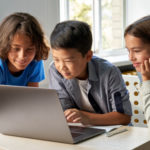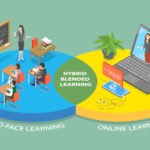Some of the best educational content develops with creative thinking and a willingness to try new things–and if teachers and students have the right tools, they’re on the right path.
Think about how students today communicate outside of school–so much of it is video-based, and if educators can meet students in that space, they’ll be able to create more engaging and impactful lessons. In the TikTok, Instagram Video and Snapchat era, video has also provided the perfect medium to encourage and empower intuitive content creation in classroom environments.
Learn more during this eSchool News webinar featuring educators and edtech experts who can speak to how video lets teachers gauge student understanding, enables students to access content at their own pace, and more.
Laura Ascione is the Editorial Director at eSchool Media. She is a graduate of the University of Maryland’s prestigious Philip Merrill College of Journalism.
![]() Latest posts by Laura Ascione (see all)
Latest posts by Laura Ascione (see all)
More from eSchool News

Who would have thought that we would still be teaching in the midst of a pandemic? At the beginning of this school year, public school districts had to make important decisions about how to approach this school year. How would they keep students safe? How would they continue to engage students in learning? And, how would they support teachers in the process?

COVID-19 arguably produced the biggest shift in education since the invention of the printing press. Nearly overnight, teaching and learning moved from classrooms to online environments. School systems invested thousands of dollars in Chromebooks, Wi-Fi hotspots, and other technologies.

It’s one thing to attend a professional development (PD) or instructional coaching session—but taking what you’ve learned and putting it into action is another. Most often, it’s the experiences built upon collaboration, reflection, and active change that make the biggest difference.

Having used the 7 Mindsets SEL curriculum for roughly six years at my prior school, I knew right away that I could help my new school optimize its SEL curriculum, which had been in place for about a year.

Over the past year and a half, “hybrid learning” has become quite the buzzword when it comes to education. With the COVID-19 pandemic impacting learners across the world, we’ve witnessed the growing need for hybrid learning, an education option that combines the benefits of a traditional in-person classroom and online learning.

As we wrapped up 2020, we thought for sure that 2021 might bring us a reprieve from pandemic learning. Well, it did, and it didn’t–virtual and hybrid learning continued into the spring, but then classrooms welcomed back students for full-time in-person learning in the fall.

Prior to the pandemic, many schools, colleges, and universities had indoor air quality challenges, but the past 18 months has brought a heightened awareness to a growing problem. Forty percent of the nation’s school systems need to replace at least half of their HVAC systems, according to a 2020 study by the Government Accountability Office.

As schools across the nation open their classrooms for a return to full in-person learning, educators, parents, and stakeholders are wondering what the fall will bring. Concerns about COVID surges and a return to remote or hybrid learning aren’t far from educators’ minds.

Technology plays a pivotal role in classrooms, and as it becomes more sophisticated, educators realize that creating active learning environments can help them effectively and efficiently use technology engage students in their learning.

When we posted our 2020 predictions on January 1 last year, we–along with the majority of the world–definitely didn’t anticipate the curveball that was (and continues to be) the global COVID-19 pandemic.
Tags best, classroom, classrooms, content creation, educational content, educators, engaging, IT, leaders, school
Want to share a great resource? Let us know at [email protected].
[ad_2]
Originally Appeared Here